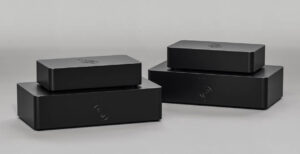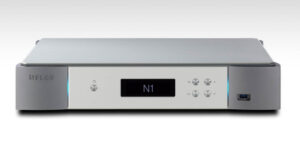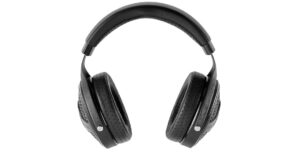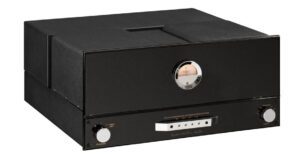High Resolution Technologies dSp and i-dSp headphone digital processors
- REVIEW
- Nicholas Ripley
- Nov 27, 2015

High Resolution Technologies is no stranger to making high-performance, low cost USB audio devices, but these typically connect a computer to a traditional hi-fi system. That world is changing: AudioQuest’s popular DragonFly points to digital audio world where portability and headphone use are uppermost. The new dSp from HRT (TLA — three letter acronyms — is the rule here) simply extends that concept to its logical conclusion.
The little red plastic dSp is designed not only to work in a conventional USB setting (it is compatible with Chrome OS, Windows, and Apple OS X), but also works with Android smartphones and tablets. There is also an iOS version, which is predictably in white and predictably called i-dSp. The Android version runs under Lollipop (version 5.0 of the Android operating system) and some devices running the earlier KitKat (version 4.4) OS, if audio is enabled in the USB host stack. Put another way, any Android device released in the last year will definitely work with the dSp, and any Android device released after October 2013 will very likely work with the dSp. As this is the fast-moving world of Android smartphones, that two-year-old cut off isn’t as limiting as it might first seem.
The principal difference between the red dSp and white i-dSp is that the red one has a Micro USB socket, whereas the white has a full-size USB port designed for Apple’s USB-to-Lightning camera adapter (available separately). However, if you have an older iDevice with the 30-pin connector, you can use the red dSp with its larger USB cable straight into the older Apple Camera Connection Kit. Both dSp devices feature 24-bit, 96 kHz DACs, both have a 3.5mm mini-jack at the business end, and both are compatible with MP3, AAC, FLAC, ALAC, AIFF, and WAV. While the hot digital audiophile topic at the moment is the inclusion of DSD, 24/96 seems a perfectly acceptable compromise under the circumstances. And those circumstances mean the dSp is the first DAC that can work with Apple’s rigid Power output restrictions.
Technically at least, no device connected to an iDevice should drain the battery on that Apple product. HRT gets around this by cleverly using extremely low power consumption. It draws about as much juice as a card reader, and yet provides both better conversion and more gain than a standard iPod, iPad, or iPhone. All this being said, the conversion within a standard iDevice is pretty good, so the biggest improvement in digital conversion seems to take place on Android devices. European users of smartphones in particular are prevented from playing their music very loud thanks to Brussels-based bureaucrats, but the DSP gets around this problem because it’s not a phone; it just connects to a phone.
If you’ve seen the portable headphone amps and DACs either on the pages of Hi-Fi+ or on the HeadFi forums, you’ll know most of them are as big as the phone the connect to, run on an internal battery, and can drive torturous headphone loads. They also typically cost hundreds. The dSp is none of these things – it’s just a good little DAC/amp to give a slight boost to a pair of regular unprepossessing headphones or earphones. No special tricks and no extra controls to handle – the volume and audio selection is controlled from the host USB device. You need to remember to silence your reminders and alerts though, because they can come through loud and clear through the headphones.
Essentially, the dSp is your phone’s sound, only better. The overall sound is direct, focused, precise, and coherent. Not massively so, but the dSp provides several small steps in the right direction. Bass in particular is more controlled, with better drive and energy, especially on full-size headphones with relatively big diaphragms to move. I’ve been warned off using too much inaccessible 20th Century music, but this did help make playing Philip Glass Glassworks [Sony] on a regular train journey to Leeds far more contemplative than I expected. Normally, Philip Glass gets grating by about Stevenage and I reach for something else, but I got all the way to Doncaster without struggling with the repetition. That’s a first!
Vocal articulation is also extremely good, and when playing through headphones one gets an ‘up close’ view of someone’s vocal talents – the more definition you can hear, the better in most cases. I played ‘Mirabai Songs’ from Barber’s Knoxville: Summer of 1915 [Nonesuch] and Dawn Upshaw’s soprano shines through. Her voice is already incredible articulate, but the dSp just brings out her diction still further.

The dSp is especially good with Android devices. I suspect this might be due to Apple keeping a tighter rein on the electronics inside an iDevice; Android having a broader set of hardware options means some Android devices turn in an outstanding audio performance, and some don’t. I think I might have encountered one of the “don’t” models, because the improvement brought about by the dSp was more marked that it was on an Apple device, even with the aforementioned kludge cable connection.
What I like about the HRT dSp is that this gives smartphone users a flavour of what good headphone audio can do on the move without either great expenditure, or strapping something as large as your phone to your phone. This is the perfect travel buddy; it has has all the appeal and weight of a Lego brick. But best of all, you attach it into your iPad, plug a decent pair of headphones into the dSp and your train or air journey just got a little better and a little bit louder. I’m no headbanger, but the volume limits on smartphones in Europe can get restrictive especially when in the air, and the extra oomph of the dSp (in both flavours) is hugely beneficial. At £79, it comes strongly recommended.
Technical Specifications
- Connections: USB 2.0 socket (micro USB with dSd), 3.5mm headphone jack
- Compatible formats: MP3, AAC, FLAC, ALAC, PCM, Windows Lossless (dSd only)
- Maximum sample rate: 96kHz
- Maximum bit depth: 24-bit
- Compatible operating systems: Chrome OS, Microsoft Windows, Apple OS X
- Compatible devices: iPhone 5 and 6, iPod Touch, iPad Mini and Air (with Lightning connector), Android devices running Lollypop OS, and most KitKat OS (with audio enabled on host USB)
- Price: £79
Manufactured by: High Resolution Technologies
URL: www.highresolutiontechnologies.com
Distributed by: Audiofreaks
Tel: +44(0)208 948 4153
Tags: FEATURED
By Nicholas Ripley
More articles from this authorRead Next From Review
See all
Reiki Audio SuperSwitch Master Pro + Servant Pro
- Mar 27, 2024

Melco Audio N1-S38 music server
- Mar 27, 2024

Focal Utopia 2022 headphones
- Mar 27, 2024











